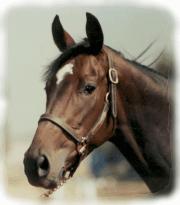A Horse, of Course with Don Blazer |
If you enjoy learning about horses, then you'll love our online courses. Each month you'll find a new column on our web site. We hope you'll enjoy it, and maybe e-mail us with questions or suggestions for other columns. A Horse, Of Course is a monthly column syndicated by Success Is Easy. If you like the column, call your local newspaper, or local horse publication and ask them to subscribe by contacting Success Is Easy. |
Avoid Pain, Seek Comfort Don Blazer copyright©2014 |

“If you work a little harder,
you’ll get better,” I said to Walter - a horse, of course. “You work a little harder and you’ll get better,” he replied. “We’re not worrying about me getting better. We’re worrying about you getting better,” I answered, politely. “I’m good as I want to get,” he said, sliding to a stop. “Stop pushing me.” “Walter”, I said, beginning my explanation, “there is very little progress without a lot of determination.” Walter began his own explanation. Humans, he said, think they know things, and they tell themselves they know things, and they invent all kinds of human rationale for doing things. According to Walter, horses don’t think they know things – they just know. Science calls this knowing “instinct”. You see, Walter explained, horses do things for one of two reasons. “We either avoid pain, or we seek comfort. That’s it.” If humans knew that, Walter went on, then they might be smart enough to understand that “no pain, no gain” might be all right for a human, but is definitely all wrong for a horse. As Walter pointed out, exercise is touted by shoe companies, body-building machine makers, fashion designers and thirst-quencher salesmen as the greatest thing you’ll ever do. They are appealing to your ego, he said. They want you to sweat, groan, moan and comfort your darkest demons. Then, of course, they want you to take some pills for the headache, some fluids for the dehydration and finally rub your aching muscles with a cream which has no odor. “From my point of view,” Walter said, “the craziest part is that they want you to do it all over again the next day, and you do. Someone has convinced you it is the smart thing to do. Your ego has actually bought into the idea of “no pain, no gain”. According to Walter, you can’t get a horse to buy into the idea. “And if you are as smart as you think you are, you won’t try,” Walter added. “No pain, no gain” is not among the two reasons horses do things, Walter reminded me. You might convince an intelligent human he or she should suffer muscle soreness, tendon pulls, strains, blisters, aches, cramps and the tearing of tissue so eventually they will look better and feel better, but you won’t sell it to a horse. Walter told me once a horse suffers the pain of over use, too much exercise or forced labor-camp work, the horse will respond to more of the same with the phrase, “No way!” Of course, Walter added, many humans take that response as a challenge instead of common horse sense. First, the human gets angry because that “dumb horse” doesn’t want to “gain from pain,” and then the human decides to show the horse who is boss. Out come the more severe bits, the bigger spurs and stronger whips. “What about the belief that if you let a horse refuse, he wins, and then you can’t get him to do anything,” I asked? “Total nonsense,” replied Walter. “Humans are supposed to be smarter, not more forceful.” “So what do you recommend?” I questioned. “Restart the horse’s exercise program the way a horse would”, Walter recommended. “We get our exercise playing,” he explained. “And when we get tired, or we sense we’ve had enough, we rest, take a breather, kick back. When we feel good again, we play again.” “Good idea,” I said. “Horse trainers should adopt the idea and instead of forcing the issue, redirect the plan to give the horse exercise in acceptable amounts.” “Oh, you’re so smart,” Walter said with a little smirk. “If both the horse and rider look good and feel good, then the gains come without the pains.” “Well, I said to Walter, “mankind believes in the no pain, no gain theory so deeply that we’ve invented mind games to help us get through the unbearable.” “Disassociation is the mind game of concentrating on something other than the pain. You are supposed to think about your work, or a vacation, or a fantasy with a movie star.” “What’s that mean?” Walter asked. “Forget that and try this,” I said. “Association is where you focus on the pain and by concentrating on the pain you get through the toughest times.” “Yeah, right!” he snorted. “Tell me one thing that the no pain, no gain theory has done for mankind that couldn’t have been achieved in another way.” I couldn’t come up with anything instantly. “Well, try this,” Walter said, “without the no pain, no gain theory, horses grow up strong and fit and healthy and happy and ready to contribute to the good of the herd. We run fast, jump high, slide stop and spin. We are athletes supreme.” “I was just trying to make you a better horse,” I said. “The idea that there has to be a little pain associated with gain is just a human quirk, I guess. After all, there are a few differences between humans and horses.” “Viva la difference!” Walter shouted. Then he walked away mumbling something like, “You are a pain in the…” *Enroll in Training Performance Horses, taught by World Champion trainer, Cathy Hanson. Learn how to train without
pain... http://www.equinestudiesinstitute.com/pht_training_course_description.html |